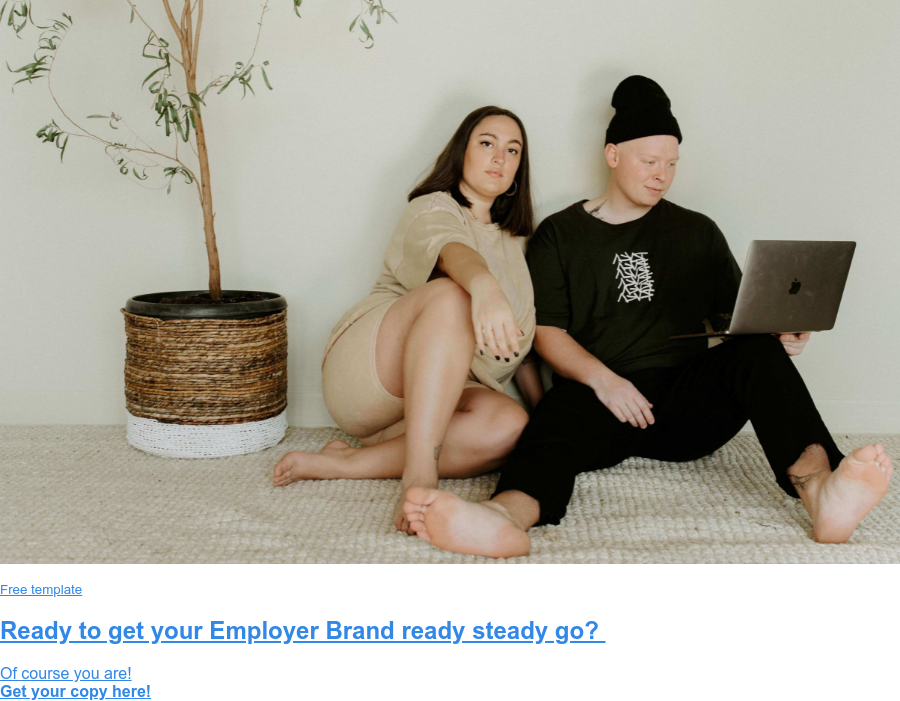Employer branding is intimately linked to the continuing importance of candidate experience - and it does raise the question: is employer branding more of a sales and marketing exercise than a Talent Acquisition tool?
The biggest and most dynamic organisations have active and well-resourced employer brands, but in small and growing organisations, where HR teams are slim (like ours! A team of 2!), what are the most important areas to take care of, and where should you outsource? And how can a strong employer brand actually streamline your candidate experience and let talent know: is this the right place for me?
Your Employer Brand Tone of Voice
You might have heard marketing teams talking about Tone of Voice (ToV). It’s a practise that - very broadly speaking - researches the target to discover who they are, what they love and what makes them tick. It also takes into account your organisation’s mission, vision, values and brand. It makes sure that every time a blog, social media post or ebook is written, the words, imagery and layout keeps the user as a priority. Result? They should be triggered to take action, such as download the ebook or comment on the social post.
Your Employer Brand ToV needs to connect with the type of candidates that you’re trying to attract (and ideally, reflect your company culture. Don’t pretend to be something your not, it will always shine through eventually)
Building a Diversity Friendly Tone of Voice
The first thing to keep in mind when it comes to language is that it is packed with norms and cultural meaning. The meaning behind the written word is powerful and impacts the reader - and not always in the direction we might wish.
For example, most job adverts use language that discourages women from applying; HR magazine found that:
"each job advert in the UK uses on average 17% more male- than female-biased words"
They continue, "This bias is found across multiple sectors, with 60% of all UK industries exhibiting significant male bias within job ads.”
With recruiters the first line in deciding who has the potential in moving forwards in an organisation, ensuring gender and ethnicity free language is an imperative element of a strong employer brand that will attract the diverse talent needed for a diversified and profitable organisation.
How to start building your Tone of Voice
Not sure how your Tone of Voice might differ from another employer’s in your industry? Think about different supermarkets you might use. Some will emphasise value; others will emphasise quality. They will both sell fresh fruit and veg, pet food, many shapes and sizes of pasta and toothpaste.
However the first supermarket might sell 5kg sacks of penne, and the other sells little cardboard boxes of bronze-dyed fancy pasta. This difference will be echoed throughout each supermarket’s adverts, social media and even the words and images on their own-brand goods.
Tone of Voice to communicate with your candidates
The same is true when you think about communicating with your candidates; long gone are the sterile days of job descriptions written in fear of anything more than strictly explaining the duties of each task, KPI and deliverable. In today’s war for talent, you must take every opportunity to show them what type of pasta you have to offer: is it the 5 kg penne or the bronze one?
Building an employer brand Tone of Voice (ToV) can help you to create a warmer, more engaging set of job descriptions, blog posts and social posts that bring your organisation alive and help candidates to know: this is the place for me.
Building a sound ToV can help candidates to ask: is this is the place for me?
Employer Branding should answer the question: is this workplace for me?
Building a strong employer brand isn’t just about showing off your team’s homegrown veg, sports prowess and ‘A Day in the Life’ posts. Employer branding also signals the mission of the organisation, and what some of your limitations are; so maybe you do amazing work but pay is limited. Or maybe pay is higher than average, but that’s because teams work longer days.
What you should be keen on doing is showing off who you are, what you are doing and WHY you are doing it.
Stick to the unique, but true, stuff.
You want to attract the right candidates, the candidates that will want to be part of your culture. And just like a consumer will remain brand loyal if the pasta lives up to the promise (no matter if that is being cheap, bronze, or that funky stripy stuff), a candidate will convert to a loyal employee if you can deliver what you have promised once they join.
Take your chance to show the world what you are really about!
Tone of voice: what you are, and what you aren't
You could be really bold like mental wellbeing start-up Spill, who define why you might be the wrong fit for a job. In start-ups and SMEs this is especially important because we need people who are quite flexible and willing to adapt with changes in funding levels, with shifting staff levels and structures. Communicating your non-negotiables as part of your brand helps candidates to know if the realities of life with you are the challenges that they want to tussle with and help you to grow.
Employer branding and unsuccessful candidates
Job hunting used to be a one-sided process: you apply for a job and feel grateful to get an interview. Today’s candidates expect more than a simple “Due to the volume of applications received” line at the bottom of an application page.
With automation and ATS bots used by 99% of Fortune 500 companies and SMEs following, there’s no excuse to not have an HR or marketing person who can create and upload some very simple emails to candidates, letting them know that they weren’t the right fit this time round - but that your organisation values their time and application.
Remember that today’s unsuccessful candidate is tomorrow’s brand ambassador.
And just as important, remember that it is not just your candidates that are listening, so are your current employees. No-one likes to be rejected, but proving your care for every candidate helps the wider talent pool to know that time spent with you is time well spent.
Outsourcing and Employer Brand
Whether you're like me, with an HR team of 2, or working with a larger organisation, outsourcing parts of your recruitment is a good-value system to streamlining your people operations, leaving you more time to build in processes like increasing feedback and consulting with your teams.
Working with external providers is a risk worth taking; when we needed to streamline our processes, we decided to work with a partner to build our career page, automation and structure.
You want to do your due diligence - especially if part of their automation will be speaking with your candidates. So do your due diligence and find out if and how these second-party services will actively build your employer brand.
Employer branding - getting going
Building an employer brand isn’t about throwing away everything you’ve done before; rather it is to remember who you are and get that message across. It is about starting to look at the words, platforms and strategies that you’re using to attract the talent that’s the right fit for your growing organisation.
There’s a lot here, we know! We’ve pulled this together into a template of action points that you can save, customise and action. As we grow our brand, we’ll keep updating the template, so don’t forget to keep checking in and keep that employer brand growing with your organisation.







